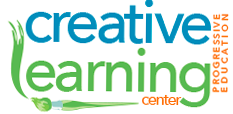How are literacy skills developed in the preschool classroom?
At CLC, we recognize the importance of early literacy instruction. Current research suggests that children who are given many language and literacy opportunities during the preschool years will become successful readers. Using a balanced literacy approach, literacy is developed through thematic units at CLC. The themes are meaningful as they engage the students in genuine projects that interest and challenge them.
During the months of November and December 2016, the children were engaged in a theme titled “Hearth and Home.” We asked questions to promote critical thinking: What makes a house a home? How do our homes today differ from homes during colonial times? What makes your home special? Bringing in photos of their own houses, the children were able to build from their personal experience as they created two-dimensional and three-dimensional representations of their homes. As they worked with the teachers in small groups, they were encouraged to express their ideas verbally and develop a rich vocabulary. According to researchers such as Lesley Mandel Morrow of Rutgers University, oral language ability plays a critical role in a child’s success in reading. At CLC, we encourage our children to practice sharing ideas, asking questions, while responding to each child individually. Throughout our unit, we emphasized new vocabulary words, such as foundation, elevation, and structure.
Math concepts were integrated through our activities as well, e.g. noticing the sides and corners of our homes and comparing those aspects of our homes to basic shapes. In our block building center, the children worked collaboratively to build homes with floors, walls, and divided rooms. This was quite a challenge for many of them, but over the course of six weeks, we noticed how their buildings expanded and improved. Where is the roof? Where are the windows? Positional words were certainly an essential part of our experiences. We placed all of our three-dimensional projects together to create a neighborhood and asked our preschoolers to think about what makes a community and what is means to have caring friendships within a neighborhood.
We read aloud to our students daily and our goal is to provide a positive experience with literature. How do we do this? We carefully select books that will inspire and stimulate our children’s hearts and minds. When we read a book, we encourage the children to share their ideas and respond to the literature. Rereading favorite books provides a higher level of listening, understanding and comprehending a text. We believe in “teachable moments” such as integrating spontaneous drama interpretations of our literature. The children often want to express their understanding by becoming a favorite character. Our dramatic play or “housekeeping” center is always open to the children and is a place where children can engage in fantasy play. Language development is stimulated as the children create play scenarios, sharing ideas verbally and solving problems. During this unit, we incorporated real world props, such as whisks, baking pans, and aprons, to encourage complex play related to our study of homes.
We always offer an art extension of our reading as well, allowing the children to share their ideas through hands-on and creative expression. During our “Hearth and Home” unit, we enjoyed many wonderful fictional and non-fiction texts. One of our favorites was The Big Orange Splot. After reading this delightful story, the children created their own dream home using paints and then dictated their ideas to the teacher. With our non-fiction text, If You Lived Here: Houses of The World, we compared homes around the world. The homes built on stilts in Venice were very intriguing to the children. The children related to this topic because many of our students have seen houses being raised up after recent hurricanes and storms. There were many questions and much discussion about these homes. As part of this study, the children were excited to represent their thoughts through an art project where they created homes with popsicle stick stilts.
Because we know that children who write become better readers, we include writing in our early childhood curriculum. We recognize “preschool inventive” writing as the beginning stage of writing and support each child’s efforts in this area. One child may want to express her ideas by writing the first phonemic sound of each word while another may be scribbling ideas at our writing center. Some children are ready to put letters together and begin forming words. During November and December, the children were excited to create written signs for their block structures and often spent much time writing the signs and discussing their placement on the buildings and neighborhoods they created.
Involving parents in our literacy program is an important part of a child’s success. During our “Hearth and Home” unit, we invited all the families to come into class to share a favorite home recipe with the children and read a favorite book. The children were very excited to share their favorite stories with their classmates, further encouraging interest in literacy and language. To culminate our studies, we put together all of the recipes into a class recipe book which was given to each of our families.
In conclusion, our “Hearth and Home” study encompassed all areas of our curriculum, with special attention to literacy skills. Print and book concepts, oral language development, phonemic awareness, auditory discrimination, visual discrimination, and comprehension skills were developed as part of this meaningful and exciting study of homes. Throughout the unit, the children were engaged in creative, fun-filled, and child-centered activities, all leading to higher level comprehension.




